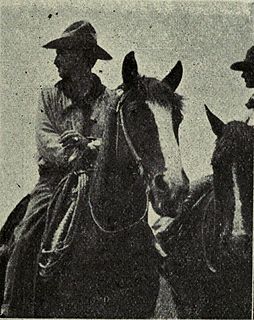| Theodore Van Soelen | |
|---|---|
| Born | February 15, 1890 St. Paul, Minnesota |
| Died | May 14, 1964 (aged 74) Santa Fe, New Mexico |
| Resting place | Rosario Cemetery, Santa Fe, NM |
| Nationality | American |
| Alma mater | St. Paul Art Institute Pennsylvania Academy of Fine Art |
| Known for | Western landscapes, portrait painting, murals |
| Spouse(s) | Virginia Morrison Carr |
| Elected | National Academician |
Theodore Van Soelen (1890–1964) was a New Mexico-based artist best known for his Western landscapes and portraits.

New Mexico is a state in the Southwestern region of the United States of America; its capital and cultural center is Santa Fe, which was founded in 1610 as capital of Nuevo México, while its largest city is Albuquerque with its accompanying metropolitan area. It is one of the Mountain States and shares the Four Corners region with Utah, Colorado, and Arizona; its other neighboring states are Oklahoma to the northeast, Texas to the east-southeast, and the Mexican states of Chihuahua to the south and Sonora to the southwest. With a population around two million, New Mexico is the 36th state by population. With a total area of 121,590 sq mi (314,900 km2), it is the fifth-largest and sixth-least densely populated of the 50 states. Due to their geographic locations, northern and eastern New Mexico exhibit a colder, alpine climate, while western and southern New Mexico exhibit a warmer, arid climate.
Van Soelen was born in 1890 in St. Paul, Minnesota. He studied at the St. Paul Art Institute from 1909 to 1911 and then at the Pennsylvania Academy of the Fine Arts. From that school he won a "Cresson Traveling Scholarship" for study in Europe in 1913 and 1914. [1] After his return a doctor recommended him to move west after a serious case of tuberculosis and pneumonia in 1916. He first settled in Albuquerque, New Mexico before moving to Santa Fe in 1922, and, finally, Tesuque in 1926. [2] He died in Santa Fe in 1964. [3]

The Pennsylvania Academy of the Fine Arts is a museum and art school in Philadelphia, Pennsylvania. It was founded in 1805 and is the first and oldest art museum and art school in the United States. The academy's museum is internationally known for its collections of 19th- and 20th-century American paintings, sculptures, and works on paper. Its archives house important materials for the study of American art history, museums, and art training.

Tuberculosis (TB) is an infectious disease usually caused by Mycobacterium tuberculosis (MTB) bacteria. Tuberculosis generally affects the lungs, but can also affect other parts of the body. Most infections do not have symptoms, in which case it is known as latent tuberculosis. About 10% of latent infections progress to active disease which, if left untreated, kills about half of those affected. The classic symptoms of active TB are a chronic cough with blood-containing sputum, fever, night sweats, and weight loss. It was historically called "consumption" due to the weight loss. Infection of other organs can cause a wide range of symptoms.

Pneumonia is an inflammatory condition of the lung affecting primarily the small air sacs known as alveoli. Typically symptoms include some combination of productive or dry cough, chest pain, fever, and trouble breathing. Severity is variable.

















